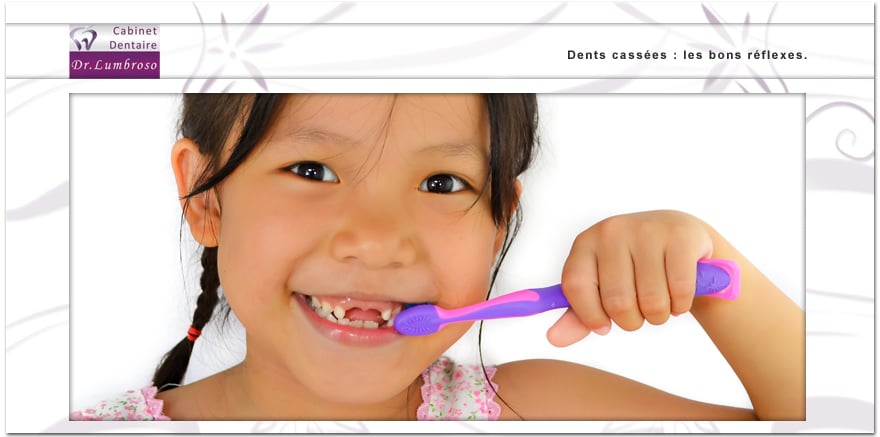Broken teeth: the right reflexes.
A dental injury is always an emergency, whether the tooth is broken or not. Treating the tooth as soon as possible optimises the chances of preserving it in a better working condition.

In children
This type of accident is common in children, due to the fragility of their teeth. The tooth expelled by the impact needs to be re-implanted within 20 minutes. This is a real emergency!
The root of the expelled tooth is covered with living cells that will allow the tooth to naturally re-attach to the jawbone. The vitality of these cells must therefore be preserved at all costs, and the root must be touched as little as possible.
Ideally, the tooth should be cleaned with saline solution and immediately placed back in its socket. If this is not possible, the tooth should be preserved in physiological serum or UHT sterilised milk, otherwise the tooth can be preserved in saliva, either in the mouth between the cheek and the lower molars (taking care that the child does not swallow it...), or in a small container.
It should be noted that in many countries there are "Save-A-Tooth Emergency Boxes" containing a special product (HBSS, Hank's Balanced Salt Solution), which allows an expelled tooth to be preserved for several hours.
It should be noted that the success rate of a re-implantation depends enormously on the extra-oral time and the medium of preservation.
In France, the number of re-implantations is estimated at 1500 per year.
Reacting quickly
Broken pieces of tooth should also be kept, as they can be glued back together! In certain conditions, this allows for almost instantaneous repair, especially if the fracture does not involve the pulp. Nowadays, new adhesives and composites allow the piece of tooth to be glued back together, or to reconstitute the broken part of the tooth if the piece is lost. X-rays are essential to check that neighbouring teeth have not been damaged. This will rule out a root fracture, even if the teeth do not appear to be broken. The dentist will prefer to have patients come in unannounced to treat the broken tooth as an emergency, rather than waiting until the end of the day (if the event took place in the morning), which would significantly reduce the chances of successful dental treatment.
The right reflexes
Once the tooth has been knocked out, the dentist disinfects it, then puts it back in place and restrains it with the help of a small wire held in place by composites. The reimplanted or repaired tooth can sometimes become necrotic (the pulp inside the tooth dies spontaneously) in the months following the shock. The initial treatment will then have to be completed. In order to monitor the vitality of these teeth, regular check-ups are necessary for up to two or three years after the shock in order to watch for any abnormalities. A change in colour is never a good sign.
Ultimately, dental trauma is never a trivial matter, whether it involves deciduous or permanent teeth. The expulsion or intrusion of a baby tooth can have negative consequences for the germ of a permanent tooth. If an abscess surfaces on a baby tooth that has never been treated, the germ of the permanent tooth may be damaged, leading to malformation of the permanent tooth.
Dental trauma is emerging as a public health problem as it affects a large number of children. 20% to 30% of children aged 12 years have trauma to their permanent teeth. Trauma to temporary teeth is common in pre-school children, usually as a result of learning to walk, accidents in the home or playing in the playground...
The incisors and canines of the upper jaw are the teeth most in need of dental care, as they are particularly exposed and stressed.
Risks for athletes
For certain high-risk sports (boxing, rugby, basketball, etc.), special equipment to protect the jaw and teeth is mandatory. It takes the form of a personalised mouthguard, made in the dental surgery using precise impressions.
It allows:
* the protection of the front teeth
* the prevention of damage to the back teeth, which may come into sudden contact as a result of a chin strike
* the protection of the lips, tongue and cheeks
* the prevention of brain and neck damage.
This mouthguard must comply with the standards of sports practice; it must fit easily in the mouth and be made according to the dental arches of each person, and allow normal mouth breathing.
Once again: "Prevention is better than cure!!!"
Dr Michaël LUMBROSO
Implant dentist / Periodontologist in Versailles
